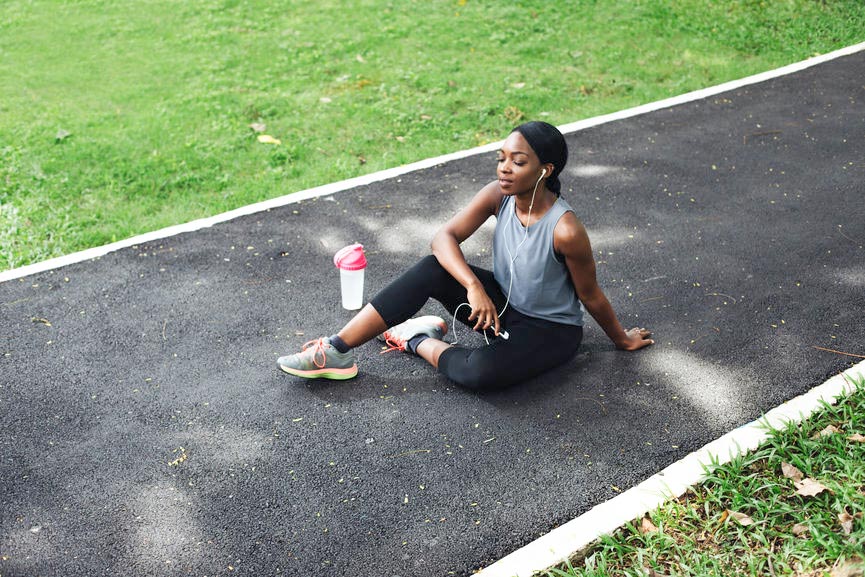Music and fitness just belong together. After all, what’s a boxing movie without a training montage, set to soaring synthesizers? The point is, music makes workouts better, and often, working out makes the music better, too.
No one understands this symbiotic relationship better than Chelsey Anderson and Faybeo’n Mickens, who program music for the fitness app Aaptiv — which seems like, well, the coolest job ever. (After writing for Haven Life, of course.) We asked them how they do it, and how even us non-professionals might use music to improve our workouts. They gave us plenty of tips, including why it’s not as simple as just throwing a bunch of songs on a streaming service’s playlist and hitting the weight room.
Keep your ear to the ground
Chelsey and Faybeo’n’s work begins with scouring the musical landscape for the next big thing, the workout staples of tomorrow. They do this not just to keep it interesting for themselves, but to keep it fresh for Aaptiv users — nothing shakes up a workout routine more easily than some new tunes. “It makes it seem fresh,” Chelsey says. “If you’re doing the same workout to the same music, it can get monotonous.”
Not that newness in and of itself is the goal. Often, what works best is a new remix of a familiar song, or a new song that has elements of a proven classic—anything that provides both freshness and recognizability. “When people can dance to it, when they know the lyrics, it keeps them moving,” Chelsey says. “Our pop remixes do really well in our cardio categories. It’s very recognizable, but it’s got the highs and lows. There are a lot of musical elements that keep you going.”
The duo gets help from the record labels, who can supply them with potential playlist additions before they’re available to the general public. You probably don’t have that advantage, but you can scour the new music Friday playlists on your favorite streaming services, not to mention the countless websites devoted to music coverage and recommendations from your hippest friends. Even if the song isn’t new, merely new to you, it can break up that routine.
Life insurance for people with a life
You budget online. You invest online. Why not apply for your life insurance online?
Read moreUse a human touch
Faybeo’n hones her skills getting people to move in a different environment: as a DJ. This provides her with real-time feedback on what works and what doesn’t, what parts of a song resonate, and the all-important art of pacing — all things a pre-programmed, algorithmic playlist can’t do.
“As a DJ, I can pick and choose when I want a song to enter and when I want a song to lose. I can pick 30 seconds or 45 seconds,” Faybeo’n says. “You’re curating for movement, for environment, for a certain brand. So you’re thinking about all those things.” It’s a level of care that a computer can’t re-create. “It takes a human touch to do it,” she says. “To some degree, there is an algorithm [to it]. But is it perfect? Can it be perfect?”
That’s not to say there isn’t some science to their art. BPM (beats per minute) is a key statistic, indicating how fast or how slow a song is. They recommend roughly 120 to 135 for a good, fast run pace. Around 110 is ideal for strength training. Turn it down to 90-100 for barre or pilates, then all the way down to the 70s or 80s for stretching or yoga. Note: You can often find a song’s BPM online or on your streaming service of choice.
In particular, pay attention to transitions, how one song leads into another. “It’s strategic song placement,” Chelsey says. “It’s not just throwing songs into a playlist and pressing go.” Oh, and both recommend hacking your playlist with this one simple trick: Use the crossfader, which fades a song out while fading the new song in.
Consider your audience. (That’s you.)
Chelsey and Faybeo’n work closely with Aaptiv’s trainers to find songs that suit their style and taste, not to mention the pace of the workouts themselves. They also QA their own work extensively, moving along with the workouts and tweaking songs and transitions here and there. And of course, it’s not just about finding a bunch of songs with the same BPM for a strength workout; it’s creating a playlist that seamlessly goes from warm-up to peak to cool down (and back again, if necessary). “I’ll try different classes and think, How can we make it better,” Chelsey says. “Maybe there was a lull here, and we should use a remix instead of the original. We try to interact from the programming to the curation just to see how we can improve.” It’s a lot of work.
Within that framework, there are a few guidelines they use. For cardio, pop remixes do well with their audience. For strength training, you want something loud and aggressive, but not necessarily fast. “That’s almost like a beast mode mindset,” Chelsey says. “You want to go full force.” Hip-hop tends to work well. “It has that energy to it. You can get a nice pace of reps without overexerting yourself.”
And while you might think first of cardio and strength training, Chelsey and Faybeo’n also program music for yoga and even meditation. “You want people to chill out without zoning out,” Chelsey says. “You don’t want to put them to sleep.” She recommends anything down-tempo, including chillwave or ambient soundscapes. “You don’t want the music to be a distraction,” she says. “You want it to be a supplement, allowing their mind to wander.”
If you want to dig even deeper, Faybeo’n mentions some other factors to consider. “The tonal or melodic quality,” she says. “A major key sounds very happy. Minor keys are more intense-sounding. The sounds you find in hip-hop or soul—[notes] a half-step higher or lower—they give another feeling to it in addition to speed.” This information can often be found in a song’s metadata in your music app of choice.
Ask: Can you dance to it?
This is a far less technical way to evaluate a song. It turns out that there’s a lot of overlap between what you hear on the dancefloor and what works in the gym, whether it’s vintage Bee Gees or from the latest Latin pop star. Why is that? Because it gets you moving and feeling good. We’re not trainers, but we’re pretty sure those are the big goals of working out.
A few genres are especially popular with Aaptiv users and trainers right now. “Latin but also funk and disco,” Chelsey says. “It goes back to that house party vibe. It has a groove to it that’s not super-uptempo, but you can find a good cadence. It just goes back to that rhythm that makes you want to move and groove and just workout.”
Start with these songs
We couldn’t help but ask what songs and artists Chelsey and Faybeo’n have in heavy rotation right now. Their answers included Billie Eilish and Lizzo, naturally. (“We’ve been fans for so long we’re ready for the new stuff,” Faybeo’n says.) There’s new tracks from Tank and the Bangas’ Green Balloon and Brittany Howard’s Jaime (“That’s really fire,” Faybeo’n says). David Guetta is huge. “I’ve been listening to a lot of Latin and Brazilian music,” Chelsey says. “Contatinho by Anitta has a really cool rhythm to it.”
And EDM remains a staple. “I love Skrillex,” Chelsey says. “Anything that makes your ears go crazy and puts you in beast mode, like you’re at a party, or raving in the front row of an EDM festival.”
So there you go. Everything you need to program your next workout playlist (and maybe, you know, actually work out), just like a pro. Still not ready? No worries. Just fire up the Aaptiv app, which is available to Haven Term policyholders at no-cost as part of the Haven Life Plus rider, listen to Faybeo’n and Chelsey’s work, and just get moving.
Aaptiv is available as part of the Haven Life Plus rider, included in the Haven Term life insurance policy. Aaptiv also is available independently of the Haven Life Plus rider, as a paid service.
Haven Life Plus is the marketing name for the Plus Rider, a rider to the Haven Term insurance policy that is available to Haven Term policyholders (except in NY, FL, SD, WA and ND). The Plus Rider is included as part of your policy, and offers access to “Plus Benefits”, which are additional products, services and benefits. Although the Plus Rider is not available in California, California residents may still be able to opt in to certain benefits and services available under this rider. Participation in the services and benefits provided are optional.
The Plus rider provides access to additional services and benefits either at a discount or at no charge for certain products and services (“Plus Benefits”). Not all Plus Benefits are available in every state. Plus Benefits are provided by third party vendors (“Partners”). Neither Haven Life nor MassMutual are responsible for the provision of Plus Benefit services or benefits. By activating a Plus Benefit, you are entering into a customer agreement with the Partner. Please review all Partner terms and conditions carefully. Plus Benefits are non-transferable, have no cash value, and are subject to change at any time.
Haven Life and MassMutual will not share your personal information with Partners, and Partners will not share personal information with Haven Life or MassMutual.
Haven Term policyholders may opt out of Haven Life Plus by contacting help@havenlife.com at any time.






